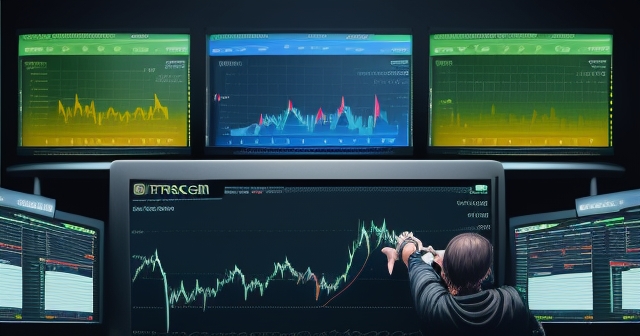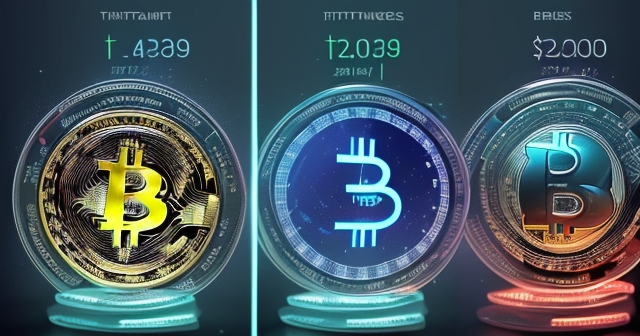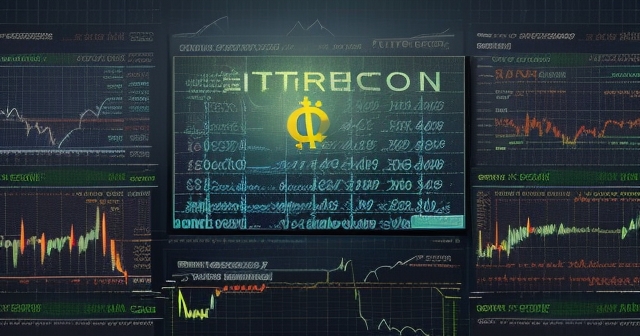Navigating Bitcoin Volatility: A Deep Dive into Short and UltraShort Bitcoin ETFs
The world of cryptocurrency investing is dynamic, often characterized by rapid price swings. While many investors focus on profiting from rising prices by “going long,” savvy traders and those looking to manage risk also need tools to potentially benefit from or hedge against price declines. For investors operating within traditional brokerage accounts in the U.S., specialized instruments like Short Bitcoin ETFs and UltraShort Bitcoin ETFs have emerged as accessible options. These funds offer inverse exposure to Bitcoin’s price movements, allowing you to potentially profit when Bitcoin’s value falls or to offset potential losses in your existing Bitcoin or crypto-related holdings.
In this comprehensive guide, we’ll explore these fascinating investment vehicles, focusing on prominent examples like ProShares Short Bitcoin Strategy ETF (BITI) and ProShares UltraShort Bitcoin ETF (SBIT). We will break down how they work, why you might consider using them, and, crucially, the significant risks you must understand before incorporating them into your strategy. Think of us as your guide, helping you navigate these complex instruments step-by-step.
Key Insights:
- Investment Options: Understand the difference between traditional long and short positions.
- Strategy Implementation: Learn how to utilize these ETFs for hedging and speculation.
- Risk Management: Recognize the complexities and risks associated with shorting Bitcoin.

What are Short Bitcoin ETFs and How Do They Aim to Work?
At their core, Short Bitcoin ETFs are designed with a specific, mathematically defined objective: to deliver the inverse performance of a particular Bitcoin index on a *daily* basis. What does “inverse performance” mean? Simply put, if the underlying index goes up by 1% today, a standard short (-1x) ETF aims to go down by 1% today (before fees and expenses). If the index goes down by 2% today, the ETF aims to go up by 2% today.
The key phrase here is “daily.” These funds are structured to reset their exposure each day to target that specific inverse multiple of the index’s daily return. They don’t aim to track the inverse of the index’s performance over a week, a month, or any period longer than one single trading day. This daily focus is critical and, as we’ll discuss, is the source of significant risk for holders over multiple days.
How do they achieve this? They don’t typically do it by directly “shorting” spot Bitcoin, which involves borrowing the asset and selling it, hoping to buy it back later at a lower price. Instead, these ETFs use financial derivatives, primarily Bitcoin futures contracts or swaps. These contracts allow the fund to gain exposure to the price movements of Bitcoin without actually holding the underlying cryptocurrency itself. By strategically using short positions in futures or swap agreements structured for inverse exposure, the fund manager aims to replicate the desired daily inverse return.
Understanding this mechanism is fundamental. You aren’t directly betting against Bitcoin’s price in the spot market when you buy shares of a Short Bitcoin ETF. You are investing in a fund that uses derivatives to synthetically create that inverse exposure with a daily reset objective.

BITI Explained: The -1x Daily Inverse Strategy
Let’s look at a specific example: the ProShares Short Bitcoin Strategy ETF (BITI). Launched in June 2022, BITI was the first U.S.-listed ETF designed to provide inverse exposure to Bitcoin. Its investment objective is clear: it seeks investment results, before fees and expenses, that correspond generally to one time the inverse (-1x) of the daily performance of the Bloomberg Galaxy Bitcoin Index.
How does BITI pursue this goal? According to its structure, it primarily invests in Bitcoin futures contracts traded on regulated exchanges like the CME (Chicago Mercantile Exchange). By taking short positions in these futures contracts, BITI positions itself to potentially gain value when the price of Bitcoin, as reflected in the index and futures market, declines on a given day.
Think of it like this: a standard long Bitcoin futures ETF bets on the price going up. BITI essentially takes the opposite side of that bet *on a daily basis*. If the Bitcoin futures market expects prices to fall, BITI’s holdings are structured to increase in value, mirroring that daily percentage drop.
BITI offers traditional investors a relatively straightforward way to implement a bearish Bitcoin strategy or to hedge Bitcoin exposure without navigating the complexities, costs, or regulatory hurdles often associated with directly shorting Bitcoin in various markets. It trades like a regular stock or ETF on major exchanges and can be bought through most standard brokerage accounts.
However, remember that daily investment objective. BITI’s performance over periods longer than a day can, and often will, deviate significantly from -1x the return of the Bloomberg Galaxy Bitcoin Index over that same longer period. This deviation is not a bug; it’s a feature of how geared (leveraged and inverse) ETFs work, particularly in volatile markets. We will explore this critical concept of “path dependency” in more detail shortly.

SBIT Explained: The -2x Daily UltraShort Strategy
Taking the concept of inverse exposure a step further, we have the ProShares UltraShort Bitcoin ETF (SBIT). Launched more recently in April 2024, SBIT is designed to provide *leveraged* inverse exposure. Its objective is to seek investment results, before fees and expenses, that correspond generally to two times the inverse (-2x) of the daily performance of the Bloomberg Bitcoin Index.
With SBIT, the potential for daily gains (when Bitcoin falls) or losses (when Bitcoin rises) is amplified compared to BITI. If the underlying index falls by 1% today, SBIT aims to rise by 2%. If the index rises by 1% today, SBIT aims to fall by 2%. This leverage increases both the potential reward and the potential risk.
Unlike BITI, which primarily uses futures, SBIT achieves its -2x daily inverse exposure through financial instruments like Bitcoin swaps. These are agreements with financial counterparties (such as Goldman Sachs or Nomura, as mentioned in market data context for related funds) to exchange payments based on the performance of an underlying asset, in this case, potentially tracking something like the performance of a spot Bitcoin ETF such as IBIT. By structuring these swaps for leveraged inverse exposure and resetting them daily, SBIT aims for its targeted daily return.
Similar to BITI, SBIT is accessible through traditional brokerage accounts, offering a way to express a highly bearish Bitcoin strategy with amplified potential returns if your timing and direction are correct *on a daily basis*. It also avoids the complexities of direct, leveraged shorting of spot Bitcoin.
However, the leveraged nature of SBIT means the risks inherent in daily inverse ETFs are significantly amplified. The deviation from -2x the index return over periods longer than a day due to compounding and volatility will likely be even more pronounced with SBIT than with BITI. This makes SBIT potentially suitable only for highly active traders who understand and can monitor its daily mechanics and associated risks extremely closely.

Why Might Investors Consider Short Bitcoin ETFs? Hedging and Speculation
Now that we understand what these funds are and how they aim to work on a daily basis, let’s explore the primary reasons an investor might consider using them. There are generally two main use cases:
- Speculating on Price Declines: Perhaps you analyze the market and believe that Bitcoin’s price is likely to fall in the near future due to macroeconomic factors, technical analysis signals, or other market dynamics. Buying shares of a Short Bitcoin ETF like BITI or SBIT provides a way to potentially profit from this anticipated decline. If Bitcoin’s price drops, the value of your inverse ETF shares should increase (on that specific day), allowing you to sell them later at a higher price. This is akin to taking a “short position” but using a regulated, exchange-traded fund.
- Hedging Existing Bitcoin or Crypto Exposure: Many investors hold Bitcoin directly, own shares in companies with significant Bitcoin holdings (like mining companies), or invest in long-only Bitcoin ETFs or futures ETFs. While you might be long-term bullish, you may want to protect against short-term downturns. Buying a Short Bitcoin ETF can serve as a hedge. If the price of Bitcoin falls, your long positions will likely lose value, but your inverse ETF position should gain value, potentially offsetting some or all of those losses. This strategy can help reduce portfolio volatility during periods of anticipated price weakness without requiring you to sell your long-term holdings.
For investors constrained by traditional investment platforms or seeking to avoid the complexities and potential margin calls of direct shorting, these ETFs offer a regulated and relatively accessible tool within the familiar framework of a brokerage account. Providers like ProShares have been instrumental in bringing these types of crypto-linked products to market, expanding the toolkit available to investors.
Accessing Inverse Exposure: Traditional Brokerage Accounts
One of the significant advantages of Short Bitcoin ETFs like BITI and SBIT is their accessibility. Unlike buying spot Bitcoin directly on a cryptocurrency exchange or dealing with potentially complex derivatives markets, these ETFs trade on major stock exchanges.
This means you can buy and sell shares of BITI or SBIT through virtually any standard U.S. brokerage account you might already use for stocks, bonds, or other ETFs. Platforms like Robinhood and others support trading in these funds.
This accessibility lowers the barrier to entry for investors who are comfortable with traditional financial markets but less so with the operational aspects of cryptocurrency platforms. It allows you to implement bearish Bitcoin strategies or hedge Bitcoin exposure using the same tools and interfaces you are already familiar with. You can place limit orders, stop-loss orders, and utilize other standard trading techniques.
Moreover, investing via these regulated ETFs often means benefiting from established infrastructure related to custody, clearing, and settlement, operating under existing financial regulations. While the underlying asset (Bitcoin) is volatile and the fund structure is complex, the method of accessing the investment is designed to be as straightforward as buying any other ETF.

The Critical Risk: Understanding Path Dependency and Volatility
This is arguably the single most important concept to grasp when considering inverse and leveraged ETFs. As we mentioned, BITI and SBIT have a daily investment objective. They aim to deliver -1x or -2x the index’s return *for that day*. Their performance over periods *longer* than a day can and often will differ significantly from simply multiplying the index’s return over that longer period by -1 or -2.
Why? Because of the effects of compounding and volatility, a phenomenon known as “path dependency.”
Let’s use a simplified example, ignoring fees and expenses. Suppose Bitcoin’s index starts at 100.
- Day 1: Index drops 10% (to 90). BITI aims to gain 10%. If BITI starts at 100, it goes to 110.
- Day 2: Index gains 11.11% (recovering to 100). BITI aims to lose 11.11% from its new value (110 * (1 – 0.1111) ≈ 110 * 0.8889 ≈ 97.78).
Over two days, the Index is back to where it started (0% change). But BITI is down from 100 to 97.78 (-2.22% change). It didn’t deliver -1x the cumulative return (which would be 0%). The daily compounding effect caused a deviation.
Now consider volatility. Imagine the index swings up and down repeatedly.
- Day 1: Index +10%. BITI aims for -10%.
- Day 2: Index -10%. BITI aims for +10%.
If the index starts at 100:
- Day 1 End: Index = 110, BITI = 90
- Day 2 End: Index = 110 * (1 – 0.10) = 99 (Index return over 2 days = -1%)
- Day 2 End: BITI = 90 * (1 + 0.10) = 99 (BITI return over 2 days = -1%)
In this scenario, the path dependency risk wasn’t apparent. But what if the swings are different?
- Day 1: Index +20%. BITI aims for -20%.
- Day 2: Index -10%. BITI aims for +10%.
If the index starts at 100:
- Day 1 End: Index = 120, BITI = 80
- Day 2 End: Index = 120 * (1 – 0.10) = 108 (Index return over 2 days = +8%)
- Day 2 End: BITI = 80 * (1 + 0.10) = 88 (BITI return over 2 days = -12%)
The Index was up 8% over two days. -1x that would be -8%. But BITI ended down 12%. The deviation is significant.
This effect is amplified in leveraged ETFs like SBIT (-2x). Small daily movements compounded over time, especially in volatile markets like Bitcoin’s, can lead to returns that are vastly different – often much worse – than what you might intuitively expect by simply looking at the total percentage change of the underlying index over a longer period.
Therefore, these funds are generally intended for short-term use, often by sophisticated traders who actively monitor and rebalance their positions. Holding them for extended periods, particularly during choppy or sideways markets with high volatility, can lead to substantial tracking differences and potential losses even if the underlying asset’s price change over that period would suggest a profit based on the stated multiple.
Beyond Daily: Performance Over Longer Holding Periods
Given the critical nature of the daily investment objective and the risk of path dependency, it’s essential to explicitly state that Short Bitcoin ETFs and UltraShort Bitcoin ETFs are NOT designed as long-term investments or “buy-and-hold” strategies for inverse exposure over extended periods.
While the goal is to provide -1x or -2x the *daily* index return, the actual performance over weeks, months, or longer will almost certainly *not* be -1x or -2x the index return over that same timeframe. In fact, due to the negative effects of compounding in volatile markets, these funds can lose value over time even if the underlying index experiences a net decline over that period, or they can lose significantly more value than expected if the index rises.
Think of it as constantly readjusting your position every single day to get that exact daily inverse exposure. Over time, these daily adjustments stack up, and the cumulative effect can diverge significantly from the simple inverse of the total change in the underlying asset.
This requires investors to be highly engaged. If you plan to hold these ETFs for more than a single trading session, you need to be aware that their performance may significantly underperform your expectation based solely on the Bitcoin index’s movement over that period. Frequent monitoring and potentially rebalancing your position are necessary if you intend to maintain a certain level of inverse exposure over time, which adds to transaction costs and complexity.
For most long-term investors, these are not suitable instruments. They are specialized tools for short-term tactical plays or sophisticated hedging strategies where the daily nature is understood and accounted for.
Short ETFs in Context: The Broader Bitcoin Market Landscape
It’s important to view Short Bitcoin ETFs not in isolation, but as part of the evolving landscape of regulated financial products offering exposure to Bitcoin. Their existence provides balance in the market, offering tools for expressing bearish views alongside the tools for bullish views, such as the popular long-only Bitcoin futures ETFs (like ProShares’ own BITO or Valkyrie’s BTF) and, more recently and significantly, the spot Bitcoin ETFs (like BlackRock’s IBIT, Grayscale’s GBTC, etc.) that launched in early 2024.
The launch of spot Bitcoin ETFs has been a major catalyst, driving substantial institutional interest and capital inflows into the Bitcoin ecosystem via traditional finance channels. While many headlines focus on these long-only vehicles, the presence and activity in the futures market (which underlies funds like BITI) and the strategies employed by institutions (some of which involve both long and short positions) are equally telling.
The availability of both long and short tools in accessible ETF formats caters to a broader range of strategies and market participants, from retail traders to professional hedge funds looking for delta-neutral strategies or complex arbitrage opportunities. This maturing market infrastructure supports increased trading volume and sophistication.
Institutional Activity and the Basis Trade
The data suggests increasing engagement from professional market participants. We’ve seen significant inflows into Spot Bitcoin ETFs, indicating strong institutional appetite for direct-like exposure. Simultaneously, there’s a growing interest in strategies that utilize derivatives, such as the “basis trade.”
The basis trade is an arbitrage strategy that exploits the difference (the “basis”) between the price of Bitcoin futures and the price of spot Bitcoin. Typically, Bitcoin futures trade at a premium to spot Bitcoin (contango). A basis trade involves simultaneously buying spot Bitcoin (or a spot Bitcoin ETF like IBIT) and selling Bitcoin futures contracts (on exchanges like CME).
The goal is to profit from the futures price converging with the spot price as the futures contract approaches expiration. While low-risk, it requires significant capital and understanding of derivatives. Recent reports and market data indicate that the yield on this basis trade has become increasingly attractive, drawing large players, including even traditional entities like the Wisconsin State Pension Board, into the Bitcoin derivatives market.
Why is this relevant to Short Bitcoin ETFs?
- The basis trade increases activity and open interest in CME Bitcoin futures, which is the underlying market for BITI. Increased liquidity and participation in futures can affect the pricing and effectiveness of futures-based inverse strategies.
- The existence of sophisticated institutional strategies involving simultaneously long spot and short futures positions highlights that “shorting” or taking inverse exposure is a fundamental part of a healthy, two-sided market, not just a retail bet on decline. Short ETFs provide one way for a broader audience to access a form of this inverse exposure.
- Increased institutional presence, whether via spot ETFs or the basis trade, contributes to the overall depth and complexity of the Bitcoin market, a context within which inverse ETFs operate.

Key Metrics and Fund Details
When considering any ETF, including inverse Bitcoin funds, it’s important to look at key metrics. For BITI and SBIT, provided by ProShares, here are some details to keep in mind:
| Key Metric | BITI | SBIT |
|---|---|---|
| Expense Ratio | 0.95% | 0.95% |
| Underlying Instruments | Bitcoin futures | Bitcoin swaps |
| Inception Date | June 21, 2022 | April 2, 2024 |
| Trading Volume | Check daily | Check daily |
| NAV vs Market Price | Possible deviations | Possible deviations |
Understanding these metrics helps you assess the potential costs and operational aspects of trading these specific funds.
Is a Short Bitcoin ETF Right for You? Considerations
Given the complexity and significant risks, particularly the path dependency stemming from their daily investment objective, Short Bitcoin ETFs and UltraShort Bitcoin ETFs are not suitable for everyone. Before you decide to invest in BITI, SBIT, or similar funds, ask yourself the following questions:
- Do I fully understand the daily investment objective? Do you grasp that the fund resets daily and that performance over multiple days will likely deviate from the simple inverse of the index’s cumulative return?
- Do I understand the risks of compounding and volatility? Are you aware that in volatile markets, holding these funds for more than a day can lead to results significantly worse than expected, including potential losses even if the underlying index goes down over the period?
- What is my intended holding period? If it’s longer than a few days, are you prepared for the increased risk of tracking deviation and the need for potential active management or rebalancing?
- What is my risk tolerance? Leveraged inverse funds like SBIT carry amplified risk. Can you withstand the potential for rapid and substantial losses?
- Am I using this for speculation or hedging? Be clear about your purpose. If hedging, understand that it’s a tactical tool, not a perfect long-term hedge due to tracking risk. If speculating, are you comfortable with the timing risk associated with daily instruments?
- Do I understand the underlying instruments? Are you comfortable with the fund using derivatives like Bitcoin futures or swaps rather than directly interacting with spot Bitcoin?
These funds are best suited for experienced traders who understand the mechanics of geared products, can actively monitor their positions, and have a clear rationale for their short-term use, either for speculation on short-term price drops or for tactical hedging Bitcoin exposure.
Conclusion: Navigating Inverse Bitcoin ETFs with Knowledge
Short Bitcoin ETFs and UltraShort Bitcoin ETFs like BITI and SBIT represent important additions to the suite of regulated financial products available to investors interested in Bitcoin. They provide accessible avenues through traditional brokerage accounts to implement bearish Bitcoin strategies or to hedge Bitcoin exposure without engaging directly with spot crypto markets or complex direct shorting techniques.
However, their power as tools is matched by their complexity and risk. We’ve emphasized throughout this guide the critical importance of understanding their daily investment objective and the significant impact of compounding and volatility, leading to path dependency over holding periods longer than one day. These are not set-it-and-forget-it investments and are generally unsuitable for long-term passive strategies.
By understanding how these funds work, the instruments they use (futures, swaps), their place within the broader market context (alongside spot ETFs, the basis trade, CME activity), and the crucial risks they carry, you can make more informed decisions. Whether you’re considering BITI for a -1x daily inverse play or SBIT for a more aggressive -2x leveraged daily inverse strategy, knowledge and a clear understanding of their mechanics are your most valuable assets. Approach them with caution, clarity, and continuous learning.
bitcoin short etfFAQ
Q:What is a Short Bitcoin ETF?
A:A Short Bitcoin ETF aims to deliver the inverse performance of a Bitcoin index on a daily basis, allowing investors to profit when Bitcoin’s price falls.
Q:What are the risks associated with Short Bitcoin ETFs?
A:Risks include path dependency, which can lead to significant deviations in performance over multiple days compared to the expected inverse results due to compounding and volatility.
Q:Who should consider investing in Short Bitcoin ETFs?
A:These ETFs are best suited for experienced traders who understand the mechanics of inverse products and can actively monitor their investments.

留言